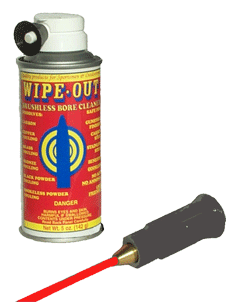 THE WORLDS ONLY BRUSHLESS BORE CLEANER
THE WORLDS ONLY BRUSHLESS BORE CLEANER
Revolutionary New Product
TAKE THE WIPE_OUT CHALLENGE:
PUT WIPE-OUT IN A GUN YOU THINK IS CLEAN !
WIPE-OUT™ is a revolutionary new product that solves all the problems encountered with conventional bore cleaners.
The primary reason for using any type of cleaning preparation in the barrel of a firearm is to remove those agents left behind which would adversely affect the accuracy of the particular firearm and its use life.
If this were not the case we could shoot endlessly with no recourse but to bring on more ammunition. Unfortunately, firearms have a fatal flaw. The products of combustion and metal fouling from bullet materials, and carbon which is a product of burning powder, produce a deteriorating effect on the accuracy of a given firearm. As these residues build up inside the barrel; accuracy decreases conversely.
It is the removal of these four types of fouling: 1. Powder fouling (smokeless or blackpowder) 2. Metal fouling (copper or lead alloy) 3. Carbon , 4. Molybdenum (usually introduced by the use of Molybdenum coated bullets), which will restore accuracy in a barrel whose usable life is still viable.
Most traditional products were never meant to remove anything other than powder fouling.
They were given a pleasant smell, but were totally in-effective for most problems that cause the loss of accuracy.
Loss of accuracy is normal in all firearms after they have been used in a prolonged shooting session.
The barrel will become fouled with gunpowder residue as a result of combustion, additionally: two other materials are deposited internally to the barrel, carbon and metal fouling from bullet material. Most of the shooters today are aware of metal fouling caused by lead alloy bullets, and copper jackets. They are also aware that powder fouling will cause the barrel to become dirty and fouled causing inaccuracy.
These two are the most difficult to remove and are the greatest cause for the loss of accuracy in a firearm. However, many are not aware that carbon is probably the most difficult product of the firing cycle to remove from the barrel.
Most of our Dads and Grand Dads didn’t tell us about these problems because they probably were unaware of them, and they thought the product they used, was effective.
In the past the removal of these types of barrel fouling has required highly aggressive chemicals such as acid and ammonia. These chemicals have been applied in the past on a patch or with a bore brush dipped in the solution. Then with large amounts of elbow-grease the brush was stroked back and forth through the barrel to scrub the fouling residues out. Then a patch was pushed through the bore, and it was checked for evidence of fouling or the lack thereof . This process is repeated until all evidence of fouling is no longer present on a patch.
The standard practice has been to dunk a copper or bronze brush into the cleaner and stroke the cleaning rod the length of the bore. Worse to scrub the brush back and forth several times.
Without a bore guide and a coated cleaning rod, this is a good way to damage the bore the throat (where most barrels wear out) and the crown.
A good deal of the evidence of fouling removal comes from the bristles in the bore brush itself.
This isn’t the best way to increase barrel life.
Many shooters have never been aware that anything more than a few quick passes with some solvent and a few patches were required to properly clean a fouled barrel. Barrels left in this condition will only continue to lose accuracy. We have seen rifles on the used rack which the owners assumed were “shot-out” , which when properly cleaned performed like they were new. When we examined some of these guns with a bore-scope, we could see fouling built up in layers like a black forest cake. Each of these would be a layer of powder fouling and carbon, usually with a layer of copper on top. I have seen firearms with six or seven of these layers built up. In every case when these guns were cleaned properly, the accuracy returned.
A more recent approach has been to product products with heavy amounts of acid and ammonia.
Acid and Ammonia will remove metal fouling and carbon. But Acid and Ammonia are dangerous to you and your firearm.
Products containing large amounts of acids and ammonia still require large amounts of brushing.
The major problem they have is that they contain chemicals which have a horrible smell, and are very dangerous to the steel used in gun barrels.
It is quite easy using these products to permanently damage the interior of the barrel with pitting. They also can remove stock finishes.
COMPETITIVE SHOOTERS AND VARMINT HUNTERS TAKE SPECIAL NOTE

Consider the effect you have on the barrel of a firearm during a cleaning using conventional products. Count the number of strokes it takes to clean your rifle using conventional solvents and a brush. Conservatively, you will find the number somewhere between 50 to 100 brushstrokes. Now take the number of times you clean that firearm during a season. And finally take that number times the number of years that you have used that barrel. The number of brush strokes is astronomical.
It is impossible to introduce the cleaning rod into the barrel of any firearm thousands of times without causing serious degradation of the quality of the performance of that barrel.
Compare that with two or three patches per cleaning using Wipe-Out™. There is no comparison!
We have always believed and strived to make a product that would leave the barrel in the same condition it was in when it left the factory.
If you’re going to wear a barrel out, do it with thousands of rounds. Not with thousands of brush strokes.

The Muzzle Adapter makes application simple
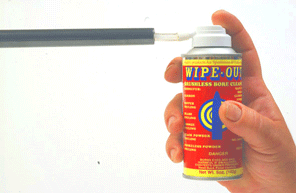
INSTRUCTIONS FOR USE OF——–WIPE-OUT™
WIPE-OUT™ has a unique new applicator tip that prevents Wipe-Out ™ from gushing back out of the barrel. Simply hold the applicator tip against the muzzle or bore guide and apply the Wipe-Out ™ All that is necessary is a short burst. Wipe-Out ™ is designed to rapidly expand into the barrel , like shaving cream. The applicator tip may also be reversed for large caliber firearms or muzzle loading firearms up to 62 caliber.
Reverse the Adapter for Large Caliber Firearms or Muzzle Loaders
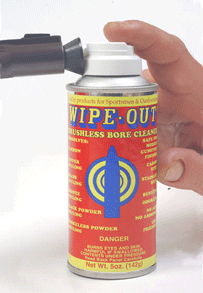
Wipe-Out ™ is simple to apply. Put the gun in a cradle or rest horizontally. Apply the product to the muzzle with your finger loosely in the chamber. Shake the can very well before applying. Push the muzzle adapter tight against the muzzle. Count one -thousand one, one- thousand two, and that should be it. You will feel the product on your finger. When the barrel is full a small amount will be present in the chamber…….it needs cleaning too. The next part is the best. Walk away! No brushing! In 60 minutes you return and push a good cotton patch through the barrel. Make sure you have a caliber specific jag. This assures a tight fit, and guarantees cleaning to the very bottom of the grooves.
BREECH APPLICATION FOR LARGE CALIBERS
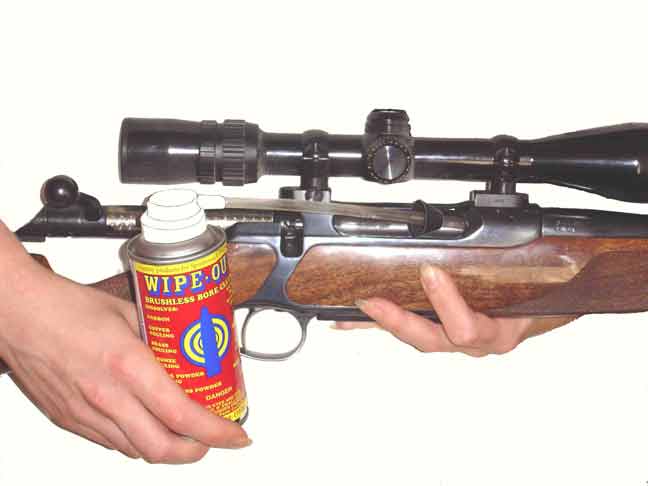
Slide a soda straw on the can spout after you remove the black adapter. Then slide the black adapter on the straw, with the adapter pointed forwards. (Like a Cone) This method is used when you are applying Wipe-Out to rifles larger than 30 caliber. The cone will block the chamber allowing you to push the straw into the neck of the chamber.
WIPE-OUT™ tells you when your firearm is fouled with powder residue, carbon, and metal fouling by the color left on a patch.
Simply apply the Wipe-Out ™ to the muzzle or to the chamber( with the use of a bore guide) until it is full. You may remove the muzzle adapter and put a plastic soda straw (Mc Donald’s is just the right size) on the can spout, if you choose to apply to a bore guide, or if you have a muzzle brake.
Set the firearm on the bench horizontally. Let it sit for 60 minutes.
After 60 minutes has elapsed, put a clean cotton patch on a jag and push through the bore.
The color on the patch will tell you what to do next.
Powder fouling (both smokeless powder and black powder) will be grayish black on the patch.
Copper fouling will be deep navy blue.

(Note the blue stain on the patch and on the product dripping off the muzzle)
Carbon will be tannish to brown in color.
Please be aware that large amounts of fouling on a very dirty firearm can build up in layers.
IF THERE IS NO COLOR ON THE PATCH……….THE FIREARM IS CLEAN.
IF THERE IS ANY COLOR ON THE PATCH: Apply the Wipe-Out ™ again to the barrel.
If the first patch showed all three colors, the gun is heavily fouled. Let the gun set for 60 minutes or more, overnight is best. Wipe-Out ™ will continue to work for 24 to 36 hours.
Wipe-Out ™ was formulated for long term soaking, to absolutely remove the most stubborn fouling.
Push a clean patch through the bore. If there is still color on the patch re-apply and let set for a longer period of time. A very heavily fouled gun may take several overnight sessions, until no color shows on a patch.
A PATCH WITH NO EVIDENCE OF COLOR IS EVIDENCE OF A CLEAN FIREARM.
Deep navy blue on a patch is evidence of heavy copper fouling.
In cases where the firearm has not been properly cleaned, or when it has been shot quite a number of times Wipe-Out ™may be applied and the gun left to set overnight.
Patch out the bore in the morning, as usual.
Re-apply Wipe-Out ™, and let firearm set 60 minutes. There should be no evidence of color.
Remember always let the firearm rest horizontally……never muzzle-up when using WIPE-OUT™.
Finally technology allows us to accomplish a really clean bore with only simple soaking.
Removal of metal fouling and carbon along with powder fouling will restore accuracy to unclean firearms.
We have found many firearms that were thought to be “shot-out” and with proper cleaning were put back into good working condition.
WIPE-OUT ™ RESTORES BARREL LIFE AND ACCURACY TO THESE GUNS.
Check out this article: Clean Faster and Easier with Tubing Fitted to your Chamber
Download the Full PDF Version Here
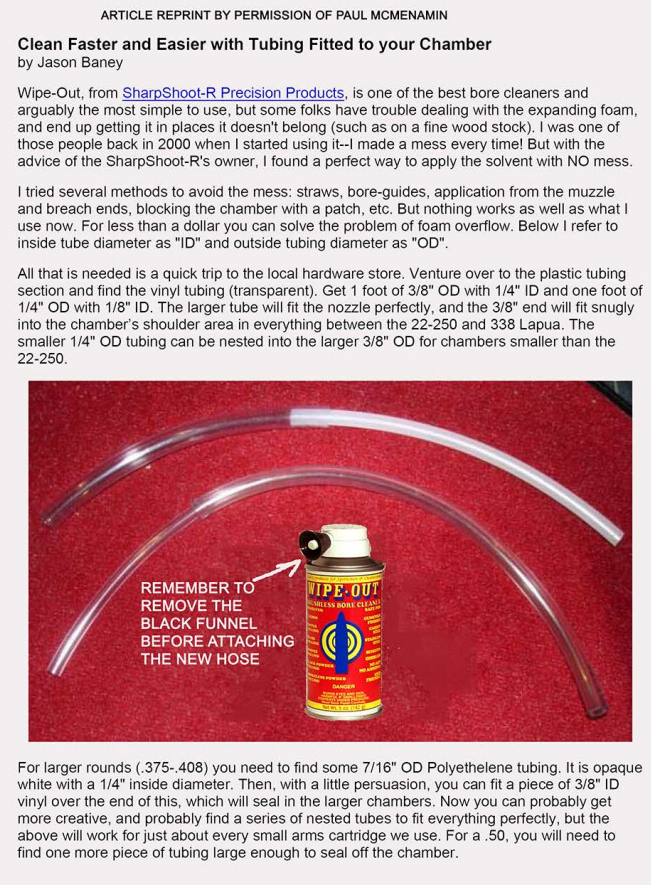
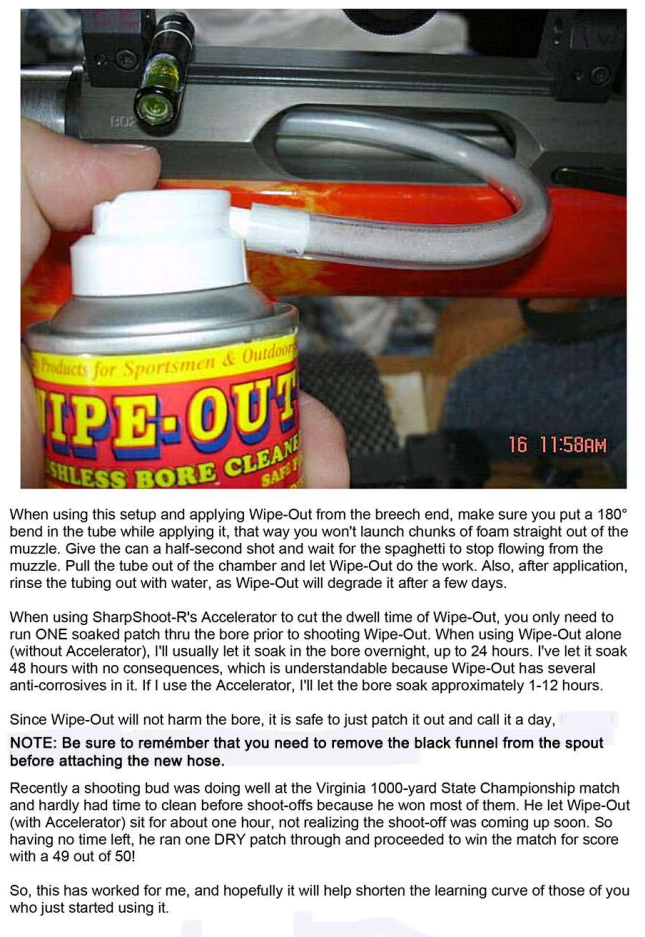
Download the Full PDF Version Here


SPECIAL NOTE FOR ALL SHOOTERS SHOOTING LEAD BULLETS.
We specifically state that Wipe-out does not dissolve lead. Most chemicals that dissolve lead produce a galvanic reaction. This reaction in effect acts like a battery. In most cases it will etch steel ( both stainless and carbon steel). It is for this reason that we don’t use chemicals that specifically work on lead.
We use chemicals that will dissolve the other metals ( tin , antimony, zinc, etc.) that are incorporated in most bullet alloys. So we work to destroy the integrity of the bullet alloy, and it begins to come apart in small black flakes. This process takes about 24 to 36 hours.
So while Wipe-Out™ does not dissolve lead , it will degrade the alloy so that it can be pushed out with a tight patch.
Black Powder :
Black Powder shooters have found that they have some specific problems that most other shooters do not. A large number of shooters today using black powder weapons, either use a plastic sabot with a jacketed bullet, or are shooting lead alloy bullets. While Wipe-Out ™ is not designed to dissolve lead, it does penetrate below the lead fouling, allowing it to be pushed out with a patch. This is true for all handguns as well as all long guns firing lead or lead alloy bullets.
Cleaning time with black powder weapons is even easier than center fire firearms. You simply apply the product to the muzzle and wait 60 minutes, then patch out the barrel. The color indicators will tell you if any fouling is present. Re-apply and repeat the procedure if necessary. The Wipe-Out ™ can has a unique muzzle adapter which may be turned around on the can spout making it possible to apply Wipe-Out ™ to almost any caliber of primitive firearm. This muzzle adapter will block up to .62 caliber weapons.
Shotguns :
The penetrants and cleaners in Wipe-Out ™ also get below the plastic fouling of sabots and allow these deposits to be pushed out with a tight patch. It is this unique property which makes Wipe-Out ™ a good choice for removing plastic fouling from the chambers of modern shotguns.
PROPERTIES OF WIPE-OUT™
WIPE-OUT™ is practically odorless and non-flammable.
It contains a rust inhibitor, and will not stain hands of clothing.
It is safe for all modern paint, gunstock finishes and steels. It however is not safe for varnish , shellac or old oil type finishes. IT WILL REMOVE THEM.
It will dissolve brass, bronze,, and copper.
It will not dissolve lead but it will degrade lead so that it can be pushed out with a patch.
WIPE-OUT™ CANNOT CAUSE RUST.
It will not gum in either the action or the barrel.
WIPE-OUT™ is safe for all barrel steels, both stainless and carbon steel
WIPE-OUT™ is safe for all barrels with a CHROME LINED BORE
SAFETY and PRECAUTIONS
WIPE-OUT™ is low in ph and because it is odorless it appears to be quite safe.
However it may cause damage to the eyes and skin. Be careful to clean hands and skin after using the product.
Flush, immediately if the product gets into the eyes. Keep out of the reach of children.
Always follow good safety procedures with this product.
Do not ingest.
Keep out of the reach of children.
Do not incinerate the can.
Do not store in temperatures above 110 degrees Fahrenheit.
For information on breaking in a barrel properly using WIPE-OUT™, contact us and request the document # 70.
WHERE CAN I PURCHASE WIPE-OUT™ ?
You may purchase directly from us!
WIPE-OUT™ is available in a 6 ounce can ……..(5 ounces of product and 1 ounce of propellant.)
There is enough Wipe-Out ™ in a can for about 75 applications.
It is recommended for rifles, pistols, revolvers, shotguns.
It works with all muzzle loading firearms.
WIPE-OUT™ will also clean flash hiders, muzzle brakes, and silencers.
It’s made in the United States and meets all governmental criteria.
WIPE-OUT™ is a totally new formula which has been thoroughly tested and accepted by firearms, ammunition, and bullet manufacturers in the U.S.
YOUR SATISFACTION IS GUARANTEED
If WIPE-OUT™ is not available from your local Distributor or Dealer ,you may purchase directly from us.
Visa, Master Card, and C.O.D. accepted. Call us at 1-785-883-4444 or send us an e-mail.
Sharp Shoot-R Precision Products
TECHNICAL BULLETIN 1:
Click here for downloadable version
WIPE-OUT ™ is a Revolutionary New Product.. PUT WIPE-OUT ™ IN A GUN YOU THINK IS CLEAN………! ! ! ! ! it’s a revolutionary product that solves all problems encountered with conventional bore cleaners. It is a revolutionary product because it is totally BRUSHLESS. And WIPE-OUT ™ is odorless ! Loss of accuracy is normal in all firearms after they have been used in a prolonged shooting session. The barrel will become fouled with gunpowder residue as a result of combustion, additionally: two other materials are deposited internally to the barrel,……. carbon and metal fouling from bullet material . These two are the most difficult to remove and are the greatest cause for the loss of accuracy in a firearm. The standard practice has been to dunk a brush into the cleaner and stroke the cleaning rod the length of the bore. Use a good coated cleaning rod and a bore guide, that way there is no damage to the bore, crown, and the throat. A good deal of the evidence of fouling removal comes from the bristles in the brush itself, (copper or bronze.) A more recent approach has been to product products with heavy amounts of acid and ammonia. While acid and ammonia will remove metal fouling and carbon, they are dangerous to you and your firearm. Products containing large amounts of acids and ammonia still require large amounts of brushing…..but nor WIPE-OUT ™. The competitive products contain chemicals which have a horrible smell, and are very dangerous to the steel used in gun barrels. There are many sad shooters who have pitted a barrel using cleaners of this type. It is quite easy using these products to permanently damage the interior of the barrel with pitting. But not with WIPE-OUT ™!
Count the number of strokes you take using conventional acid and ammonia base cleaners. Conservatively it is over 100 strokes. Take that number times the number of times you clean your firearm (monthly or annually or weekly ), and then again multiply the number of years you have owned the piece. Conservatively you will have a number in the thousands of strokes you put thru that barrel. It is impossible to put a cleaning rod into the best of barrels several hundred thousand strokes without compromising the quality of the barrel in some way.
With WIPE-OUT ™ each cleaning session takes no more than 2 or 3 patches.
BOTTOM LINE IS THAT WIPE-OUT ™ WILL KEEP A GREAT BARREL IN PREMIUM CONDITION LONGER THAN ANY OTHER CLEANING METHOD.
BRUSHING A BARREL IS “DARK AGES” TECHNOLOGY.
INSTRUCTIONS FOR USE OF——–WIPE-OUT ™
THE FIRST FIREARM YOU CLEAN WITH WIPE-OUT ™ SHOULD BE ONE YOU THINK IS CLEAN.
Simply hold the applicator tip against the muzzle or bore guide and apply the WIPE-OUT™. All that is necessary is a short burst, generally a -two count works. WIPE-OUT™ designed to rapidly expand into the barrel, likee shaving cream. The applicator tip may also be reversed for large caliber firearms or muzzle loading firearms up to 62 caliber.WIPE-OUT™ may be applied to the breech end by removing the adapter on the nozzle and replacing it with a plastic soda straw(Mc Donald’s or Subway has the right size). Push the straw into the neck of the chamber and apply. We introduced a great new applicator that has an 8″ hose the WSA-007.
WIPE-OUT ™ is designed to work with out brushing. Allow to set for 20 minutes. Push a clean patch thru the bore. Now use the “PROOF TEST” apply a second application, and allow it to set for 10 minutes. If you get no color on the second patch, you have proof that the barrel came clean in the first 20 minute session. Because WIPE-OUT ™ contains 3 anti corrosive ingredients it is not necessary to put oil in the bore. The oil will increase carbon deposits. This will also remove the necessity of taking fouling shots. Your first shot will in the middle of the group.
WIPE-OUT ™ tells you when your firearm is fouled with powder residue, carbon, and metal fouling by the color left on a patch. What you must do is get to a clean barrel, where you have no color showing on a patch. Simply apply to the chamber( with the use of a bore guide)until the barrel is well coated. Set the firearm on the bench horizontally. Let it sit for 10 minutes. After 10 minutes has elapsed, push a clean cotton patch on a jag through the bore . Heavily fouled guns or those cleaned with other products should be left overnight on the first cleaning. Patch out in the morning. Re-apply WIPE-OUT ™(The Proof Test) and wait 10 minutes. Push a patch thru and check for any color. If color is present…….re-apply and let set overnight. Repeat the “proof test” in the morning procedure.
Once the gun is really clean,…….a normal shooting session (20 to 60 rounds) can be cleaned in less than one hour. You have to get the barrel clean to start with…….The reason we ask you to start with a gun you think is clean ………….is so that you will understand what ineffective cleaners have been leaving in your barrel. Also there may be a distinct layering effect of fouling which is caused by an ineffective cleaning. The barrel may actually have as many as 7 or 8 layers of fouling which is probably the most difficult to remove.
The barrel with this type of fouling may take 2 or 3 overnight applications of to finally get to a colorless clean patch.
Powder fouling (both smokeless powder and black powder) will be grayish black on the patch .Copper fouling will be deep navy blue. Carbon will be tannish to brown in color . Please be aware that large amounts of fouling on a very dirty firearm can build up in layers. IF THERE IS NO COLOR ON THE PATCH……….THE FIREARM IS CLEAN.
IF THERE IS ANY COLOR ON THE PATCH: Apply the WIPE-OUT ™ again to the barrel. If the first patch showed all three colors, the gun is heavily fouled. Let the gun set for 60 minutes or more . Push a clean patch through the bore. If there is still color on the patch re-apply and set for a longer period of time. Whenever possible the easiest method using WIPE-OUT ™ is to LET IT SET OVERNIGHT.
REMEMBER THE FOLLOWING: A PATCH WITH NO EVIDENCE OF COLOR IS EVIDENCE OF A CLEAN FIREARM .
Deep navy blue on a patch is evidence of heavy copper fouling .In cases where the firearm has not been properly cleaned, or shot quite a number of times (varmint shooting) WIPE-OUT ™ may be applied and the gun left to set overnight, with no harm to the firearm. Push a clean patch to the bore in the morning , Re-apply WIPE-OUT ™ foam, and let firearm set 60 minutes. There should be NO EVIDENCE OF COLOR ON A PATCH. Always let the firearm rest horizontally……never muzzle-up when using WIPE-OUT ™
Removal of metal fouling and carbon along with powder fouling will restore accuracy to unclean firearms . We have found many firearms that were thought to be “shot-out”, when cleaned properly, the original accuracy was restored .
These guns were simply cleaned ineffectively. WIPE-OUT ™ cleans the bore without brushing . A single application will work for 72 hours, so it’s not necessary to re-apply frequently to get a stringer mix.
WIPE-OUT ™ RESTORES BARREL LIFE AND ACCURACY.
——-before
——-after
It’S odorless and non-flammable,
It contains a rust inhibitor, and will not stain hands of clothing .
WIPE-OUT ™ is not safe for varnish , shellac or old oil type finishes. It will remove them. However WIPE-OUT ™ is safe for all the modern finishes ( poly-urethanes, and epoxys.)
It will dissolve brass, bronze, and copper. Most aluminums (AR-15/M-16 receivers and all aluminum pistol frames) are safe with WIPE-OUT ™ , but some will discolor to a dull grey. IF you have any doubt try a test area where it will not be visible.
WIPE-OUT ™ will NOT DISSOLVE LEAD but it will degrade lead so that it can be pushed out with a patch.
WIPE-OUT ™ contains no acid and no ammonia. WIPE-OUT ™ CANNOT CAUSE RUST. It will not gum, or form solids in either the action or the barrel
WIPE-OUT ™ is safe for all barrel steels, both stainless and carbon steel. Note: WIPE-OUT ™ will remove Molybdenum.
SAFETY and PRECAUTIONS
PATCH-OUT is low in ph and because it is odorless it appears to be quite safe. However prolonged contact may cause damage to the eyes and skin. Always follow good safety procedures with this product. Do not ingest Keep out of the reach of children.
WIPE-OUT ™ is a convenient to use liquid that will completely clean a firearm in a few minutes.
There is enough WIPE-OUT ™ in a bottle to clean more than 100 firearms.
It is recommended for rifles, pistols, revolvers, shotguns, and it works with all muzzle loading firearms.
WIPE-OUT ™ will also clean flash-hiders , muzzle brakes, and silencers
M.S.R.P.price is $14.99 per 8 ounce bottle.It ‘made in the United States and meets all governmental criteria .
Try New ACCELERATOR™ it will double the speed of WIPE-OUT ™ and double the amount of fouling removed, especially copper and carbon. An 8 ounce bottle of ACCELERATOR™ retails for $10.99 per bottle and will last through about 3 bottles of Patch-Out™. To apply, simply put on a nylon brush with ACCELERATOR™ and WIPE-OUT ™ together.
TECHNICAL BULLETIN 2:
Click here for downloadable version
HOW TO USE THE “PROOF TEST” ©
The “PROOF TEST” is used any time you need to know what condition the barrel is in. We use the “PROOF TEST” when we need to know if a firearm is clean or needs to be cleaned.
TO RUN A “PROOF TEST” you put an application of either WIPE-OUT ™ or PATCH-OUT ™ in the barrel of the gun you wish to test. Let this application set in the barrel around 10 minutes. Push a single patch thru tho bore. If there is any fouling present in this barrel it will show up immediately on the patch. 10 minutes is long enough for the chemicals in our formula to react to any sort of fouling.
1.Copper will show up on the patch with a deep navy blue color.
2.Carbon will show up on a patch as the color brown.
3.Powder fouling will always be gray or black in color.
4. Molybdenum will show up as long black stripes ( it’s coming off the bottom of the grooves)
No color or a clean white patch is evidence of a clean barrel.
We use this test any time we are not sure of the condition of the bore…….or to determine if we need to re-apply
either WIPE-OUT ™ or PATCH-OUT ™.
WHAT TO DO IF YOU SHOW COLOR ON A PATCH AFTER RUNNING THE “PROOF TEST”
If you get any color on the patches it will be necessary to re-apply either WIPE-OUT ™ or PATCH-OUT ™ and then let them set of another overnight session. Color on a patch after an overnight session is evidence that the cleaning products used in the past have been in-effective. The most heavily fouled firearms usually do not require more than 3 overnight applications. Run the “PROOF TEST” after each overnight session to see in the firearm is once and for all finally clean.
DIRECTIONS FOR A BADLY FOULED BARREL
Badly fouled barrels that show color after the “PROOF TEST” should have another application of either WIPE-OUT ™ or PATCH-OUT ™ and should be left to soak overnight. Patch out the barrel the next morning and re-run the “PROOF TEST” . No color means you have a dead clean bore. Now you should be able to put 20 tp 50 rounds on this barrel and clean it in something less than 1 hour……in most cases under ½ hour. NO MORE GUESSING…….The “PROOF TEST” is the most reliable way to determine the condition of your firearms.
If necessary and you have a barrel that is heavily fouled with copper, you always have the option to use some ACCELERATOR ™. This product may be used in conjunction with either WIPE-OUT ™ or PATCH-OUT ™
TECHNICAL BULLETIN 3:
Click here for downloadable version
Barrel Break In
Document#70 ©
Let’s start by discussing the particular nature of the inside of a barrel in a modern firearm. There are practically no standards of barrel material (which may be carbon steel or stainless),nor are there very many standards in the methods of producing the rifling inside. With this in mind it is easy to understand why there are not many “givens” in the process of barrel break in. Most of the barrels produced fall into two classes. “Factory barrels” are those that come your major brand complete firearm. “Custom barrels” produced by independent custom manufacturers, that offer a wider range of selection and generally a much higher degree of quality. The “Custom barrel” is usually installed by your favorite gunsmith or custom rifle maker.
The rifling process starts with thru-drilling a blank of barrel steel. The straightness of this primary hole drilling is just as important as the following methods of rifling are. Barrel makers have a varied number of grooves in the rifling they can produce. This process is usually achieved by either one of three methods. The way most barrels were made for centuries was to “Cut” rifling in the barrel by the means of a Hook and Broach. Today most barrels produced by this method are called “Cut Rifle Barrels”. The second method of producing rifling in a barrel is called “Button Rifled Barrels”. A button made usually of a carbide steel alloy, is forced thru the barrel to produce a “Button Rifle Barrel”. Lastly is the “Hammer-forged barrel” which is produced by first thru- drilling an oversize hole, placing a mandrel inside which has the rifling on its exterior. The barrel blank is then “hammered” with tremendous pressure in a 360E manner to shrink the barrel down around the mandrel. All of these processes are capable of producing barrels that can produce incredible accuracy.
Let’s get a couple of things straight in our thinking. You probably have heard about “rough” barrels, and very “smooth” barrels. I can tell you for a certainty that there are both “rough barrels “and “smooth barrels” that have great accuracy. The “rough barrel” will, however, generally allow fouling to build up quicker. You have to be aware of this fact when you are breaking in your new barrel. You will be looking for factors that will help you determine which of the two groups this new barrel is going fit in. If it’s going to be in the “rough barrel” group you’re just going to have to clean more often. “Custom barrels” generally have been lapped to one degree or the other before they leave the factory. It’s a good idea to find out from the maker if this is part of their practice because lapping will start the break in process. “Factory barrels” have no general rule either when it comes to lapping. You need to check this out in every instance. Lapping can smooth the barrel and help to minimize the build-up of fouling. Lapping by the way is achieved by using a mild abrasive on a patch and “working “ on the rough spots, a process done exclusively by feel.
Just what the heck comprises fouling ? Well fouling in a barrel really could be considered anything that is deposited after a round has been fired. Fouling build-up is what causes a barrel to lose accuracy. Fouling is found in three major categories, and several minor ones. Lets look the”majors” first !
1. Powder and primer fouling leave a gritty greyish black residue. Powder fouling generally has some degree of corrosive nature on any type of steel. Black powder fouling is highly corrosive and needs to be removed immediately. Shooting a black powder firearm can give you a much better understanding of what the negative nature of fouling is, because a black powder firearm will lose accuracy due to fouling after a very few shots ( 4 or 5 shots usually) Smokeless powder fouling is not as pronounces because it produces less residue than black powder. Clean burning powder is a good thing ! There is still a lot of military ammunition around that uses highly corrosive primers and powder. This fouling like black powder needs to be cleaned and neutralized immediately. You also need to know what the fouling threshold is an any particular firearm. This is part of the education you receive in barrel break in. By the way powder fouling is deposited over most the inner barrel surface.
An ugly sub-species of fouling is the particular propensity of the deterrent coating on ball powder. This fouling is normally present in the area directly ahead of the throat. It is one of the most difficult form of fouling to remove. It is powder fouling, but leaves a particularly nasty form of hard carbon fouling that is almost crystalline in nature.
2.Carbon fouling is caused by the by products of burning powder. Carbon fouling can also be caused by the burning oil you left in the barrel. Carbon will always look brown on a patch, and it is distinctly different in color from powder fouling. Carbon is usually deposited in the rear 20 percent of the barrel You can see lots of carbon build-up in the”throat area of the barrel. The throat is just forward of the chamber. A bore scope will also show you just what the flame temperature of the powder will do to the throat. You will see a lot of fissures and cracks in the steel, and these are generally filled with carbon. When the “throat “ is gone or “shot out”, so is the accuracy of the barrel. Carbon fouling is probably the most difficult to remove, because it has a great”cling” factor. Cool burning powders are a “good thing.”
3. Copper fouling in general has been one of the most over-looked areas of barrel fouling. Most of the old traditional “Powder Solvents”, are just that. They get rid of most f the powder fouling, some of the carbon, and NONE of the copper fouling. I personally have seen many rifles that had as many as 6 or 7 distinct layers of fouling, just like a “Black Forest Torte”. There are many firearms, the dealers tell me; are traded in because the owner believes the rifle is “shot out.” In most cases they are badly copper fouled, and are in need of a good cleaning. When the copper is removed these rifles return to their previous accuracy. Copper fouling is generally found in the last 20 percent of the barrel. The reason for this is that this portion of the barrel is where the bullet has achieved maximum velocity, and maximum friction. Believe it or not, most of the barrel heat is caused by bullet friction. Flame temperatures from burning powder can be felt in the chamber area. Bullet friction is felt at the end of the barrel. You should notice that the mid portion of the barrel is a bit cooler than either one of the previously mentioned. Rifle target shooters and varmint hunters for the most part have been long been aware of problems caused by copper fouling. If copper fouling is present it is easily visible to the naked eye. Look down the muzzle end of the rifle using a strong light. If it’s there, …….there will be pronounced copper streaks on the rifling. In the past the only way to remove copper has been with strong solutions containing lots of ammonia. The removal always required lots and lots of brushing. Along with that there have been lots of rifles that were not “shot out” they were “cleaned out.” Just count the number of passes you take thru a barrel using this stuff. Then multiply that number times the number of cleanings, and finally multiply that number times the age. The product is thousands of strokes through a barrel. There is NO way you can pass a cleaning rod thru a barrel that many times and “NOT” compromise the quality of the barrel. Brushing is not a “good thing.”
With all this in mind we now can turn to the task itself of breaking in a new barrel. Generally we can say that most new barrels are “broken in” somewhere between 50 and 150 rounds. In my personal experience I have seen some factory barrels that would not settle down in to shooting good groups until 200 or so rounds had been fired. You should be able to see a marked improvement in grouping as the barrel “breaks in”.
Firstly you need to make sure that your new barrel is dead clean. Apply Wipe-OutTM or Patch-OutTM and let it sit for an 20 minutes. Patch out the barrel and re-apply Wipe-Out ,or Patch-OutTM letting the second application sit of at least 10 minutes. This second application is a “Proof Test”. It will ‘ prove’ if the first application really got the barrel clean. Ten minutes is long enough for the chemicals in Wipe-Out to react if there is any fouling left in the barrel. Remember that copper will leave a blue patch. Powder fouling will leave a patch greyish black. Carbon will always leave a brown color on the patch. If, after the second application of Wipe-Out or Patch-OutTM there is still color on the patch, you will need to re-apply Wipe-Out or Patch-Out TM and let it set overnight. When you get a clean white patch, using Wipe-Out, that means that the barrel is “dead clean”. (WE CONSTANTLY USE THE PROOF TEST WHENEVER WE ARE NOT SURE IF A BARREL IS CLEAN.)
THE ACTUAL BREAK IN PROCESS
We can now start the ” break in” process. What we want is to let the barrel tell us how far we are in the “break in “ process. I also recommend using a good coated one piece cleaning rod and a bore guide in the cleaning process. Be sure to use a caliber specific jag and good 100% cotton patches.
What we are going to do is to always shoot for a group. It is group size that is a major factor in determining if your barrel is breaking in. The groups should get progressively smaller as the barrel is breaking in. You would have no idea of your progress if you were pinned to the old method of “one shot and clean’. Most good modern barrels will be “broken in” in somewhere between 25 and 150 rounds.
Step # 1
With a clean barrel the first thing I recommend is to fire three shots, using ammunition that I know is accurate in this cartridge. Remember that we are shooting for the best grouping possible. The concentration of shots into a small group will also tell us how far along the barrel is in the “break in “ process. I then apply Wipe-Out or Patch-Out TM and let the bore cleaner sit for approximately 20 minutes. Pay close attention to the color left on the patches, because the color will tell you what is going on in the barrel with regard to fouling.
Step#2 (no evidence of copper on the patch)
Apply the second application of Wipe-Out or Patch-OutTM …….the “proof test” application, and let it set another 10 minutes. If you do not get any color on the patch after this second application, you then know that the initial application really did clean the barrel. You may the proceed shooting 5 three shots, cleaning 20 minutes after each group of three. I normally will fire around 5 groups of three shots. I am interested to see if the groups are getting smaller. The barrel will tell you what you are removing by the patch color.
Step #3
Now I normally will increase to four shot groups. The first 4 shot group you will clean for 20 minutes. Now do the proof test for 10 minutes on this first 4 shot group. You may the proceed shooting 5 four shots groups, cleaning 20 minutes after each group of three.
Step #4
Lastly, I will then progress to five shot groups. The first 5 shot group you will clean for 20 minutes. Now do the proof test for 10 minutes on this first 5 shot group. If I get evidence of huge amounts of copper on the patch after the second application, it will probably be best to drop down to shooting groups with 2 shots. Just make sure that the barrel is clean, with no color on the patches using the “proof test”.
The barrel may still show evidence of copper after total 100 rounds has been fired in groups of two, three, four or five . That is not indicative of anything other than the fact that this barrel will copper foul easily and it will need to be cleaned more often.
Step #5
Conclusion
Now it’s time to evaluate the end of the break in cycle,……..after the last 5 shot group is fired and the barrel has been cleaned. In this process you will have fired somewhere between 65 and 85 rounds. But the most important fact is that , all along the way we have been shooting groups. We know that, as the barrel is breaking in ….the groups are getting smaller. When those groups stop shrinking in size………..the barrel is broken in.
Many custom barrels will show little or no copper during the “break in” period. What is most important is that the barrel is clean between each group firing. As the barrel is breaking in you will be able to realize a definite improvement in group size. Smaller for a change, is always better. The beauty using Wipe-Out or Patch-OutTM in the “break in “ process is the fact that the barrel quality has not been compromised by endless amounts of brushing. Nor are you using a witches brew of 4 or 5 chemical products, each accompanied by more and more brushing.
If you have any questions please do not hesitate to call. I will be happy to help you with any questions you may have.
Refer to price list for pricing
Please check out our price list and catalog!